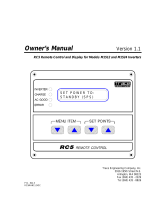
E11
16. CD Player Control and Operation
The operation and control of all Naim CD players is based on a common user interface. This section of the manual describes
the user interface, drawing attention to dierences between players where they occur.
The CD player control buttons are duplicated on the remote control handset which may also provide some extra functions.
The handset also provides CD programming facilities. See Sections 17 and 18 for more information.
16.1 Player Controls
door: Opens and closes the door (CD555 only).
disp: Scrolls through the display options of track,
time and display o (CD555 only).
Note: The CDX2, CD5 XS and CD5si display options can
be scrolled by pressing the remote handset disp key.
prev: Steps through the disc backwards, either one
track at a time, or sequentially if the button is
held.
next: Operates in the same way as the prev button,
but moving forwards instead of backwards.
pause: Pauses play. Pressing pause a second time will
resume play. The pause button indicator will
ash when pause is selected (CD555 only).
Note: The CDX2, CD5 XS and CD5si can be paused by
pressing the remote handset pause key.
Note: If a player is paused for more than 10 minutes it
will enter a “static pause” mode in which the transport
deactivates to reduce wear. The player can be left in static
pause mode indenitely. The pause button indicator will
illuminate fully when the player is in static pause mode.
stop: Stops play and resets the player to its start
condition. Pressing and holding stop will clear
any programmed play order, or, if no play
order is programmed, return the player display
to its defaults.
play: Plays a disc from track one unless another
track has been selected. Pressing play while a
track is playing will re-start the track.
16.2 Player Control Modes
CD players have an optional control mode. This provides an
alternative interface in which fast forward and fast reverse
(rather than step forwards and step backwards) can be
selected by pressing and holding the CD player next and
prev buttons respectively. The alternative interface also
provides a pause function on CDX2, CD5 XS and CD5si
players selected by pressing and holding the play button.
To select the optional mode press and hold next while the
player switches on. To select the standard control mode
press and hold prev while the player switches on.
16.3 Player Display and Indicators
The alphanumeric display indicates track and index
numbers, time in minutes and seconds, or system messages.
If a play list is programmed the time displayed reects the
duration of the programme. Depending on the model in
question, some or all of the indicators described below will
be found adjacent to the display:
HDCD: Indicates that an HDCD encoded disc is
playing.
Note: HDCD decoding is not implemented in the CD5si.
repeat: Indicates that repeat has been selected from
the remote handset.
prog: Indicates that a play list has been
programmed.
track: Indicates display of number of tracks or
current track.
pause: Indicates that the player is paused.
stop: Indicates that the player is stopped.
play: Indicates that the player is playing.
time: Indicates display of disc time or track time.
16.4 Output Socket Selection
A pair of RCA Phono output sockets are tted on CD player
rear panels to provide an alternative to the preferred DIN
socket. Proceed as follows to select the RCA Phono sockets.
With the player stopped, press and hold the remote
handset disp function (handset in CD mode) or, if tted,
the player disp button until the CD player prog indicator
ashes. Further operations of the disp function will now
cycle through each combination of the two socket types
(DIN only, RCA Phono only or both). The selected option is
indicated on the CD player display as shown below.
Socket Option Player Display
DIN O
Phono O O
Both O O O
Press and hold the disp function a second time to exit from
socket selection mode.
To avoid compromised sound quality, do not select both
unless their simultaneous use is unavoidable.


















